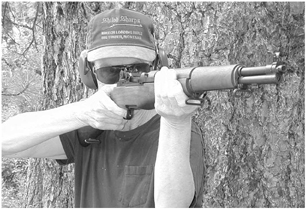
The M1 Garand just won’t fade away. The rifle, first designed in the late 1920s by John C. Garand (as a .276) and officially adopted in 1936, saw service in WWII, Korea and in Vietnam. The design was copied by several countries, even by enemies of the U.S. during the latter stages of WWII. Of course, it is still with us today, though most existing Garands have been arsenal rebuilt to one extent or another, and it’s a rare Garand that has all its numbers matching. Unlikely as it may seem, Garands are still being “manufactured” today. At least one source (Springfield, Inc.) uses brand-new receivers, but even that company and several others use refinished, reconditioned, checked and rechecked older GI parts for the rest of the rifle. New stocks are not a big problem, because walnut trees grow in abundance. New Garand barrels can be easily made, but not many newly manufactured Garand parts are forthcoming as of this writing. That will, of course, change over time assuming continued demand, but be prepared to spend important money for the existing and steadily diminishing crop of Garand spare parts, not to mention the few remaining outstanding examples of the rifle in all-original condition.
But all is not lost. Interest in shooting, collecting, or just having an example of the Garand is still very high. We found three sources of Garands for this report, from the Civilian Marksmanship Program, Fulton Armory, and from Springfield, Inc. (also known as today’s Springfield Armory, but distinct from the original armory of that name). We acquired a rifle from each source, looked ‘em over, shot ‘em, and marveled at ‘em. Here’s what we found.

CMP Greek Issue Service Grade Garand 30-06 Springfield, $550
M1 rifles are again available through the Civilian Marksmanship Program (CMP). There is a half-page ad in the August 2005 American Rifleman magazine to that effect, or you can look online at <www.odcmp.com>. The CMP also has had a recent program in which it visits a few large gun shows nationwide and brings rifles for inspection and purchase by gun club members. Our test rifle was purchased by one of our staff at the Houston Gun Collectors’ (Texas’ largest gun club) January 2005 gun show. While nothing beats first-hand inspection (assuming you know your Garands), that’s not the only way to get one. You may be lucky enough to have a presentation of CMP Garands in your area, or you can take the more common route and select from the generally accurate descriptions found on the CMP website, fill out the required paperwork, and buy your Garand that way. The way it worked at the gun show, our buyer picked out his gun, and it was then tagged with his name and phone number. He later filled out the paperwork and mailed in his check. In the case of this test rifle, it took only one month for the gun to arrive at the buyer’s home. During that time, the CMP raised the price $100 from what our buyer paid, to the price shown above.
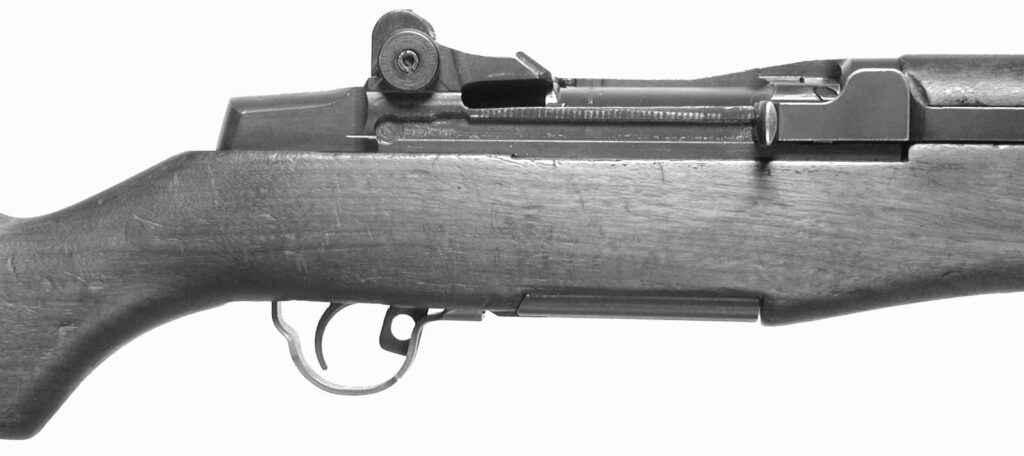
There are plenty of options available as to rifles currently on hand, but of course the on-hand rifles change from time to time. Prices, as this is written, range from $325 to $1400 for rifles with varying degrees of remaining life and finish, and also depending on scarcity of origin. (Everyone wants a Winchester.) You can also buy stripped actions at present. The CMP website also has information on field-stripping the M1 as well as discussions of various accessories for the rifle. If you have any interest at all in one of these historic rifles, you’d do well, we think, to pay the CMP website a serious visit.
Our Greek Issue CMP rifle’s receiver was made by H&R, and it also had an H&R barrel (different number). It came to us full of grease, so field-stripping was in order, which was easily accomplished. If you don’t know how to take down a Garand, a fine booklet comes with the CMP rifle that explains it. Also, Smith’s Small Arms of the World gives photos and takedown steps. You can download a Garand Manual (as a PDF) from Springfield, Inc., and Fulton Armory also tells how to take one apart. The illustrated CMP booklet that accompanied the rifle also detailed the ammo requirements, approved handling methods, and other good-to-know info. Those of us new to the M1 learned, from that booklet, how to load the rifle with fewer than eight rounds.
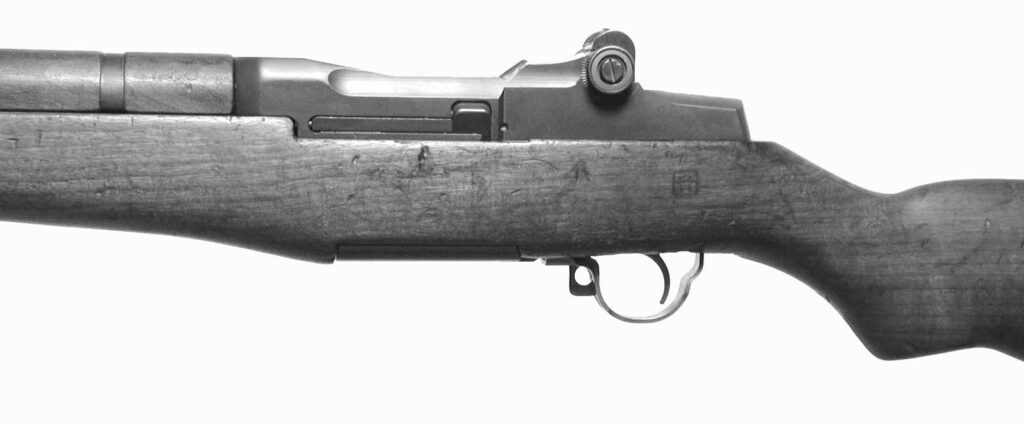
On inspection of the guts of the CMP Garand as we cleaned out the grease, we were again taken with the intricacy and cleverness of this masterful design. The parts were carefully made by methods rarely used in today’s military rifles. Once the grease was out we reassembled the gun and continued with our inspection. The wood was decent walnut with many small nicks and dings, and with some oil soaking around the action. Some of this oil can be easily removed by carefully applying heat and using paper towels to soak up the oozing oil. We thought the wood would clean up well, if the owner wanted to do so. Or it could be left as is, showing its honest wear, without harming its value in the slightest. There was a cartouche stamped into the wood just above the trigger on the left side of the stock. The receiver’s serial number was in the 5.5-million range. All the metal showed excellent Parkerizing with no signs of wear. We suspected it had been redone. The barrel looked to be in excellent condition. It was time to find out how well it shot.
We tested with only two types of ball, some good Berdan-primed surplus of European origin packed in Garand clips and headstamped “AMA 80,” herein referred to as the “good” ammo; and with some not-so-good Korean-made surplus ball headstamped “PS 75.” The latter is commonly available today, and while it utilizes fine, annealed, Boxer-primed cases (with crimped and sealed primers), our experiences with the Korean ammo were not that great. We note that some shooters use modern hunting ammo in their Garands, but experts advise keeping the bullet weight to 165 grains or lighter. Fulton Armory, for instance, recommends Black Hills Gold ammunition loaded with 165-grain Nosler Ballistic Tip bullets to avoid problems from lead deposits from common soft-nose bullets.
On the range, our first group with the just-reassembled rifle was all over the paper. We shot more to let the rifle settle its parts together, and groups got much smaller, finally averaging a bit over 2 inches with the better ammo. With the poor ammo (which exhibited great velocity variations and one example of poor ignition), groups were about 3.5 inches, not at all bad, we thought.
There were no malfunctions with this CMP rifle — nor with any of the rifles, which didn’t surprise us. The CMP rifle had the worst trigger pull, hard and creepy, though by no means the worst trigger we’ve encountered in mil-type rifles. The second stage broke at 6.5 pounds, with 4 pounds needed to overcome the first stage.

Fulton Armory Service Grade 30-06 Springfield, $1400
As can be read at the Fulton website (www.fulton-armory.com), the Garand had a long history: “First adopted in 1936, the M1 Rifle served the U.S. in World War II, Korea, a host of ‘police actions’ and interventions, and, in the hands of allies, in the Vietnam War. Even there the U.S. Army fielded accurized sniper M1 rifles even though the M1 had by that time been supplanted by the M14 and, later, the M16.” There are many more valuable bits of info at that site, not only about the Garand, and it’s worth a long visit. We visited the FAQ area at the Fulton website and immediately clicked on a dozen items to find out more about the rifle, its care and feeding. We found a trove of information.
Prices for Fulton M1s start at $1400 for the “Service Grade” rifle. Prices escalate to $1700 for the “Competition Match” model and on up to $2080 for the “Peerless” model, with heavy Krieger barrel, glass bedding, NM trigger, and all the trimmings. You can have either of the latter grades in .308 or ‘06, and the Service grade may be had in either of those calibers, or in .270.
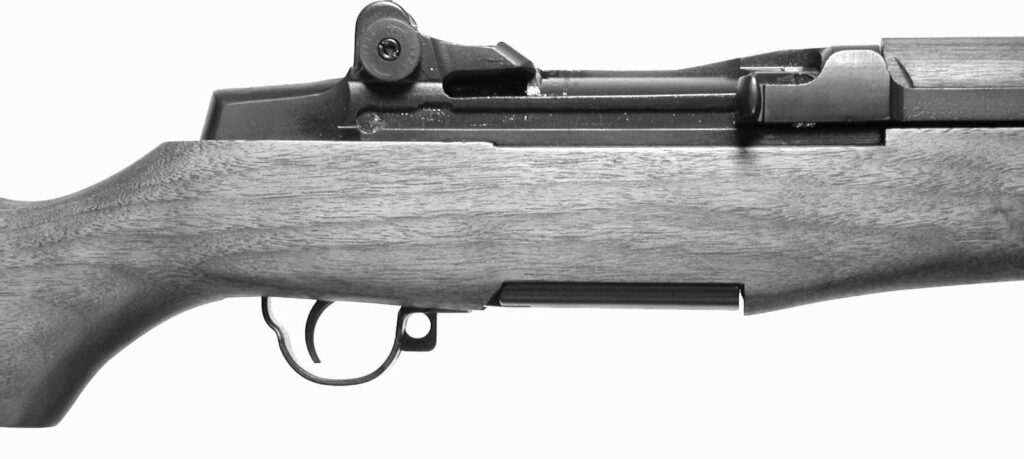
These Fulton rifles are all newly manufactured rifles using thoroughly checked original actions and other GI parts, all reworked and refinished as necessary. They have new barrels, and new walnut stocks and handguards. They are essentially Garands rebuilt to absolutely new specifications. Many fine accessories such as a chromed bore, NM trigger, NM sights (which Fulton notes are not legal for official “Garand Matches”), and other items can be added to your rifle as your desires and pocketbook dictate. In each rifle package you also get The M1 Garand Owner’s Guide, by Duff, a sling, and guaranteed accuracy that gets better with price: 2.5 inches with the Service, 1.5 inches with the Competition, and sub-one inch with the Peerless grade. These accuracy guarantees are based on the use of Black Hills match ammo.
So the Fulton Armory Garands are indeed serious rifles for serious riflemen. How good are they? One of our staff shooters has had two triggers worked over by Fulton Armory’s headman, Clint McKee. One trigger is on an M14 and the other on an M1. Our staffer declares them to be the finest triggers in his extensive gun collection, each breaking the second stage at 1 pound over the 3.5 pounds needed for the first stage. Our test rifle had a trigger break at a total of 4.9 pounds, with 3.6 needed to overcome the first stage. There was no creep.
Our first impression of the Fulton Garand was very positive, the new and somewhat fancy black walnut dully gleaming around the fresh metal in the stout and well-padded shipping box. We found a pleasing cartouche impressed into the wood, bearing the marks F.A. over CMcK, for Fulton Armory, Clint McKee. There was no looseness anywhere on the rifle, unlike the CMP and Springfield rifles. The fine wood was proud of the metal everywhere, much as original Garands must have been. This would allow for wear, shrinkage, and refinishing over time, though we doubt any serious shooter would soon want to refinish this stock. It’s just too nice to mistreat. The action was by Springfield Armory in the 1.5-million range, and all the metalwork was crisp, well finished, and precisely fit. The rifle was ready to go, so we ran a patch through the bore and repaired to the range.
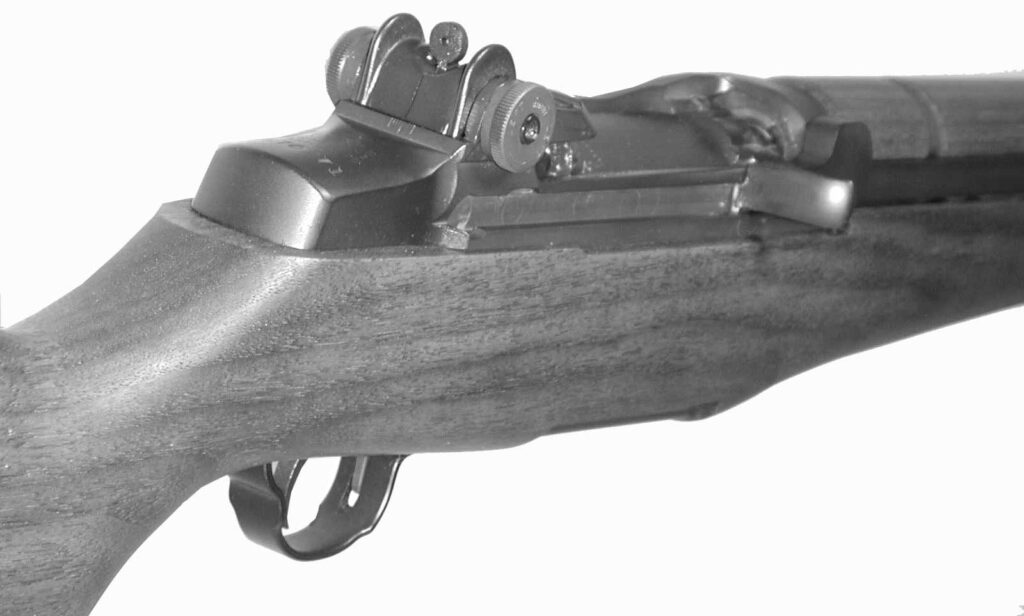
We were immediately treated to the best accuracy (with the good ammo) of this trio of Garands. The smallest three-shot group of this test was 1.2 inches, with an average of just under two inches. The poor Korean-made ammo made one group of 1.3 inches, best of the test with that fodder, but one of the rounds made a nasty pop, and the bullet landed seven or eight inches away from the aim point.
We had no doubt this rifle would fulfill the maker’s claim of “sub-2.5” groups with top-notch match ammo, and do it all day long. Heck, it did better than that with our surplus GI fodder.
Springfield M1 Garand 30-06 Springfield, $1348

The Garand from Springfield had a new investment-cast receiver, new barrel, and a new black-walnut stock. Per the Springfield website (www.springfieldarmory.com), the rest of the parts were U.S. GI mil-spec units. All the metal was freshly Parkerized. The cast action showed more green color than the remainder. Springfield Garands are available in .30-’06 or .308 Winchester, the .308 version being slightly more expensive at $1378. A decent Garand manual is available as a download from the company website.
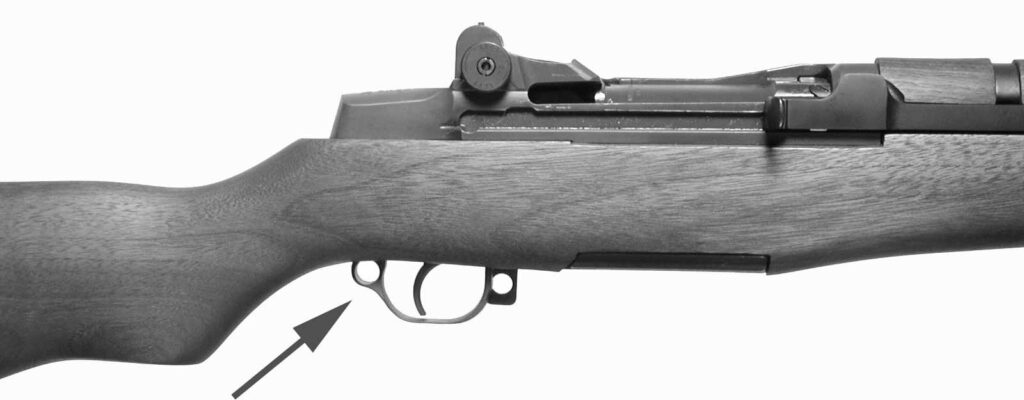
The walnut of this rifle was quite plain, though obviously stout and fully serviceable. (The Fulton spoiled us!) The grain was well oriented for strength, but the wood finish looked slightly dingy, we thought. But in fairness, that is how most Garands look. The fit and finish were all well done, except that the forward hand guard was a bit loose. We had no qualms about Springfield’s investment-cast action because we know the company has an extensive history with its fine M1A, which utilizes a similar cast-steel receiver, as do all Ruger rifles. One item we noted was the milled trigger guard, which featured a hole for a cartridge. That made takedown a bit easier for some of us, though we noted there was less finger room within the milled trigger guard than in the more-common stamped one. This rifle was on loan from an active shooter. We noticed a slight mar on the front of the floorplate, but the wood near it was not marred, so we doubt the blemish was there when the rifle was new.
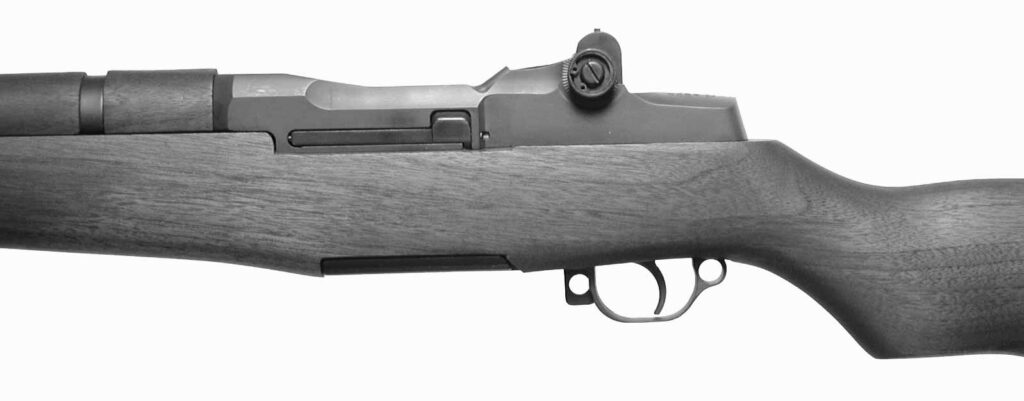
The trigger pull was not quite as good as the Fulton’s, but was not bad, with a final break at 5.5 pounds with barely perceptible creep. On the range, the rifle proved to be completely reliable, and accurate enough to suit us just fine. In fact, with our limited shooting, it averaged the best with the Korean ammunition, just under 2.4 inches. There were no problems with the rifle whatsoever.
Gun Tests Recommends
• CMP Greek Issue Service Grade Garand, $550. Buy It. We thought the CMP program was an excellent way for qualified shooters to get a thoroughly safe rifle, one that many would-be M1 shooters could embrace. You probably won’t get a tackdriver, but will get one that is sound, and which represents (and maybe shows) a lot of history. Any of the CMP rifles are well worth having and studying, let alone shooting. The M1 experience is a good one, we believe, and the CMP is to be congratulated for keeping up this policy of offering sound rifles to civilians. If you don’t plan to shoot your Garand in serious matches and can be satisfied with a fine taste of history, a service-grade CMP rifle might be just right for you.
• Fulton Armory Service Grade, $1400. Our Pick. We liked this rifle very much. It was the most attractive of the three, had the best trigger, best wood, best accuracy, and a price that was, we thought, fully justified. We’d pick this one over the other two without hesitation. Most of us felt it was probably the best M1 available today, being accurate, thoroughly within new Garand specs, and with a high degree of authenticity because of the use of original GI actions in its makeup. Also, we have experienced more of a personal touch from Fulton Armory than from most rifle makers, and that counts for a whole lot in our book.
• Springfield, Inc. M1 Garand, $1348. Buy It. We could not fault this gun in any way. Workmanship was excellent, and everything worked properly. Price was, we thought, fair for what you get, but for about the same money, most of us liked the Fulton better. If you are looking for a new Garand with a new action, this is probably the one you want, and we believe it’ll serve you very well. Some of our testers were more than happy with this Garand.
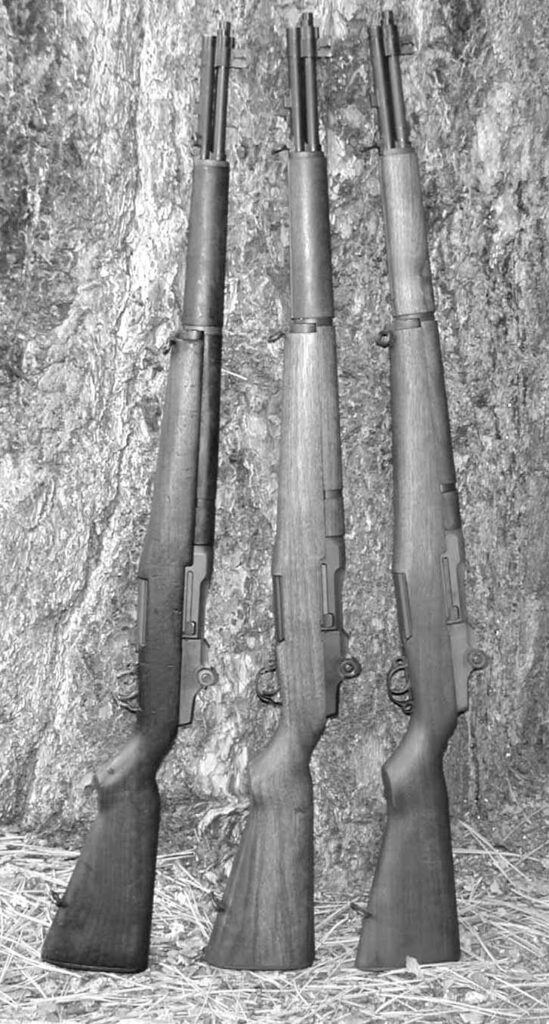




























When will my m1 rifle be shipped.i can’t wait to get it.